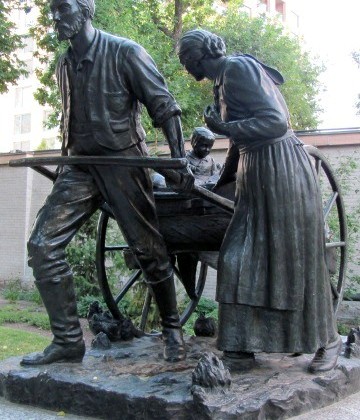Solving Homelessness: Notes from My Visit to Utah
The state of Utah conjures up many things for people, but perhaps most prevalent is the noting that it is a deeply conservative place culturally and politically. So headlines saying that Utah had effectively ended homelessness stood out even more than they might have had say Minnesota made the same claim. However, what I learned from the people I met with in the state offered some pretty straight forward ideas about why they’ve had success and why they haven’t ended homelessness. Here is a quick summary of leaders from non-profits, the state, and the church. I haven’t quoted anyone so that they could speak freely and openly about what they’ve learned.
In some ways, Utah is the perfect place to look at how state and local governments are addressing homelessness. It’s true that the state is conservative, but it was also founded by refugees. It’s easy to forget when looking at the imposing temple in the middle of downtown Salt Lake City that the state was settled by people who were essentially homeless, pushed and hounded across the country over decades by unprecedented religious prosecution. Many families making the trip to what would become Salt Lake City would bury their family members, including many children, along the side of the trail. Everyone I talked to affirmed that not only was it leadership from the church that helped give their efforts direction and gave it political force, but that the culture of communal self-preservation was part of it too.
There were three key points echoed by everyone I talked with. The problem needs a definition, there has to be good data, and the solutions should be based on outcomes, not following formulas or inputs.
Defining the Problem
The simplest and most obvious definition of homelessness is people without housing. But even that gets complicated. Does shelter count as housing? Is person homeless when their sleeping in a family members basement? What about intermittent homelessness or situational homeless that resolves itself? These and many other questions are all the questions people working on the problem asked. The decision was made to put most energy into chronic homelessness,
Unaccompanied adult with a disabling condition homeless a year or more or four times in three years.
That definition and the decision to tackle that group was not and is not without controversy. There are many homeless people that fall outside that definition. But what I heard was that without a definition the problem becomes unmanageable to solve. The 10 year plan model to end homeless is a model that fails almost immediately because it simply can’t deliver on the promise in it’s name. The question then has to become about what is the worst part of the problem in terms of suffering and cost.
Using Good Data
As I’ve pointed out many times, taking on any housing issue is about getting the numbers right. After arriving at the definition the question was, “how many people are there in Utah that are chronically homeless?” After assessing the population in 2005 that number was 1,932 people. That’s a comparatively small number, but when considering the complexity of the problems in this population along with the length of time they have been living homeless, it becomes a significant challenge. One analysis found that for one year, a person had cost the state $563,000 in emergency room visits. Another chronically homeless person had $937,744 over three years in emergency room visits.
What overlapped in Utah was compassion and cost. The chronically homeless were suffering the most and costing the system the most. But because they are fewer in number they are also better known to the system. That means bigger challenges per person, but fewer people and people who already have a relationship with the system. This also means they are easier to track and gather information about progress toward ending their condition.
Measure Success Using Outcomes
I heard a familiar frustration from those I talked with that was familiar: there are too many limits and rules at the front end of the housing system. Whether it is paperwork and applications to get funding or a system that measures success with the number of encounters or visits or how full a shelter is or isn’t, the problem with the way government works on homelessness often comes down to incentives. If a organizations are limited and rewarded by filling out grant forms, successfully managing a shelter, or making a set number of outreach visits, those things become the measure of progress rather than how many people have moved out of homelessness.
Nobody questioned the motivation of people in the system, but how the system didn’t hold everyone in it accountable to reducing the problem. And there is no way to do that without a good definition of the problem and data about the problem. So outcomes became the focus rather than the “how” of the outcome. The leadership of Utah’s effort had political support to challenge the accretion of bureaucracy to move the dial on solving the problem. By 2015 the number of chronically homeless people had failed from 1,932 to 178.
Did Utah just define it’s way out of the problem? Not really. Nobody suggested that there is no more homeless problem or even that the state will continue to struggle with the problem indefinitely. But what I heard was a lot of political investment from elected officials and moral leadership from the Mormon church and involvement from the private sector. The politicians provided the resources, the church the cultural imperative, and the private sector money. These things matter when it comes to moving a bureaucracy, entrenched interests, and good people protecting their constituents.
In my next post, I’ll suggest what this might mean for our own homeless issues here and especially for the encampment problem.


